If you’re looking to bring stunning greenery into your home, ficus trees offer an impressive range of options that can transform any space. With over 850 known species, these versatile plants come in various sizes, from compact 6-inch varieties to towering 10-foot specimens. Each type brings its own unique features – whether it’s the Weeping Fig’s graceful branches or the Fiddle Leaf’s dramatic leaves – and they’ll thrive in your indoor environment with the right care approach.
Contents
Classic Indoor Ficus Trees
1. Weeping Fig Tree
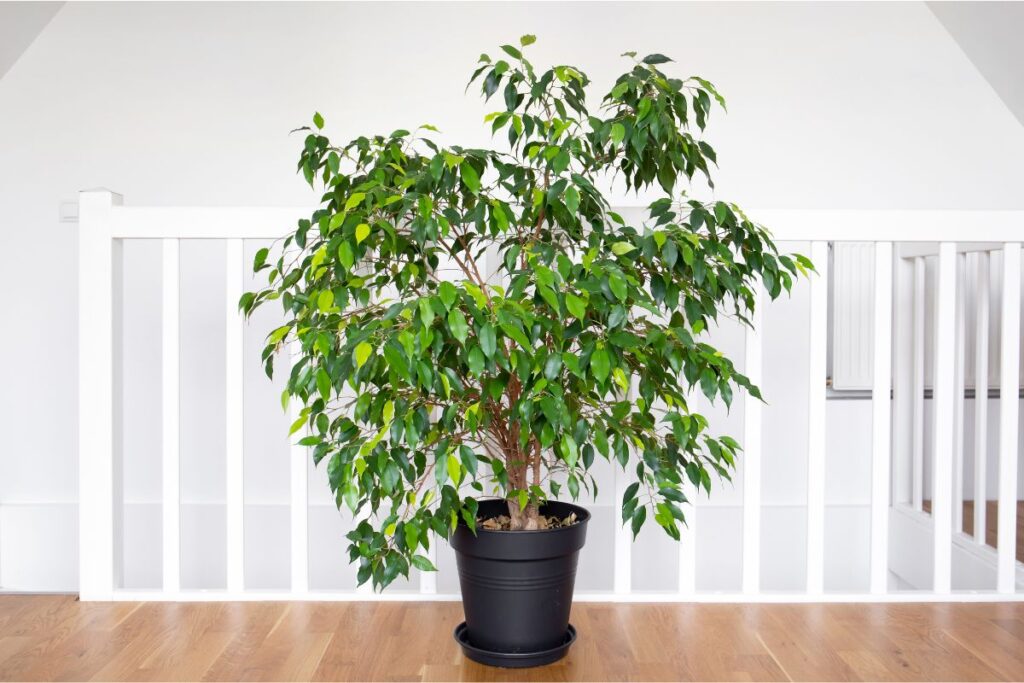
The Weeping Fig Tree (Ficus benjamina) is one of the most popular indoor ficus varieties, known for its graceful drooping branches and dense, glossy foliage. This tropical tree features slender, dark green leaves that taper to a point, and it can reach heights of 60 feet in its natural habitat but typically stays between 6-10 feet when grown indoors. While beautiful, the weeping fig can be somewhat temperamental, often dropping leaves when moved or exposed to environmental changes.
- Light: Bright, indirect sunlight; can tolerate some direct morning sun but avoid harsh afternoon light; maintain consistent light levels
- Water: Keep soil consistently moist but not waterlogged; water when top inch of soil feels dry; reduce watering in winter
- Soil: Well-draining, rich potting mix with good aeration
- Humidity: Prefers high humidity (50-70%); benefit from regular misting or humidity tray
- Temperature: 65-75°F (18-24°C); protect from cold drafts and sudden temperature changes
- Fertilizer: Feed monthly during growing season with balanced liquid fertilizer
- Soil pH: 6.0-6.5, slightly acidic to neutral
2. Fiddle Leaf Fig Tree
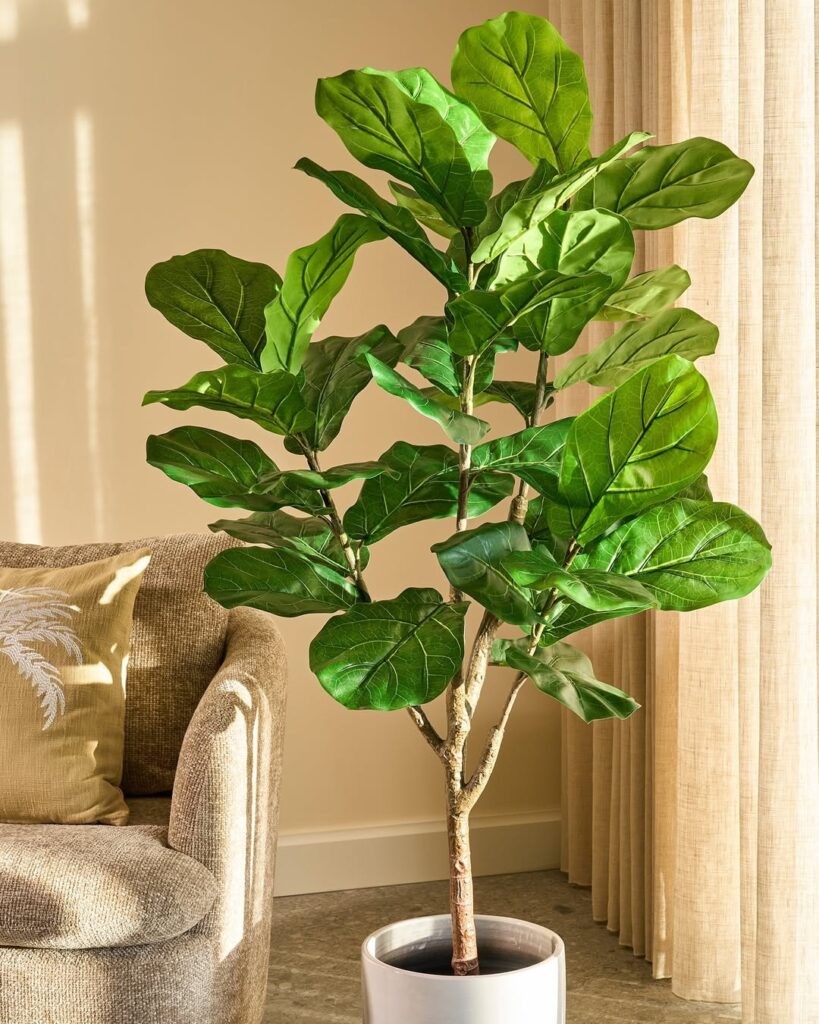
The Fiddle Leaf Fig (Ficus lyrata) is a striking indoor tree known for its large, violin-shaped leaves and impressive height potential of up to 10 feet when grown indoors. Native to western Africa’s tropical regions, this popular houseplant features dark green, leathery leaves with prominent veining, creating a bold architectural statement in any room. While beautiful, it has earned a reputation for being somewhat finicky, requiring consistent care to maintain its health and appearance.
- Light: Bright, indirect sunlight; can tolerate some direct morning sun; avoid harsh afternoon sun
- Water: Allow top 1-2 inches of soil to dry between waterings; reduce watering in winter
- Soil: Well-draining, rich potting mix with good aeration
- Humidity: Prefers high humidity (60% or higher)
- Temperature: 60-75°F (15-24°C); avoid cold drafts
- Fertilizer: Feed monthly during growing season with balanced liquid fertilizer
- Container: Use a pot with drainage holes and repot every 1-2 years
- Growth: Moderate to slow growth rate; may need staking for support
3. Rubber Plant
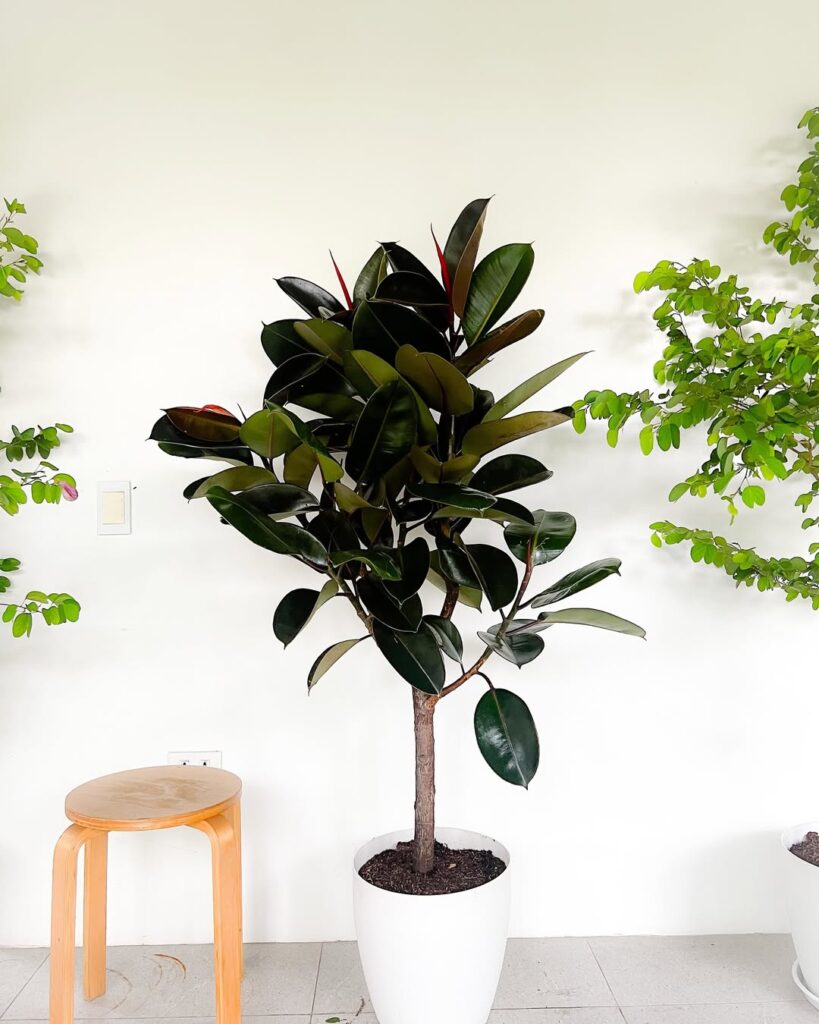
The Rubber Plant (Ficus elastica) is a popular indoor tree known for its large, thick, glossy leaves that can range in color from deep green to burgundy, depending on the variety. Native to Southeast Asia, this striking plant can grow up to 100 feet tall in its natural habitat but typically reaches 6-10 feet when grown indoors. Its broad, oval-shaped leaves feature prominent veining and a waxy coating, making it an attractive focal point in any room while also serving as an effective air purifier.
- Light: Bright, indirect light; can tolerate some direct morning sun but avoid harsh afternoon light; adapt to moderate light conditions
- Water: Allow top 1-2 inches of soil to dry between waterings; reduce watering in winter; sensitive to overwatering
- Soil: Well-draining, rich potting mix with good aeration
- Humidity: Moderate to high humidity; benefits from regular misting or humidifier
- Temperature: 60-75°F (15-24°C); avoid cold drafts and sudden temperature changes
- Fertilizer: Feed monthly during growing season with balanced, water-soluble fertilizer
- Repotting: Every 2-3 years or when roots become pot-bound
4. Banyan Fig Tree
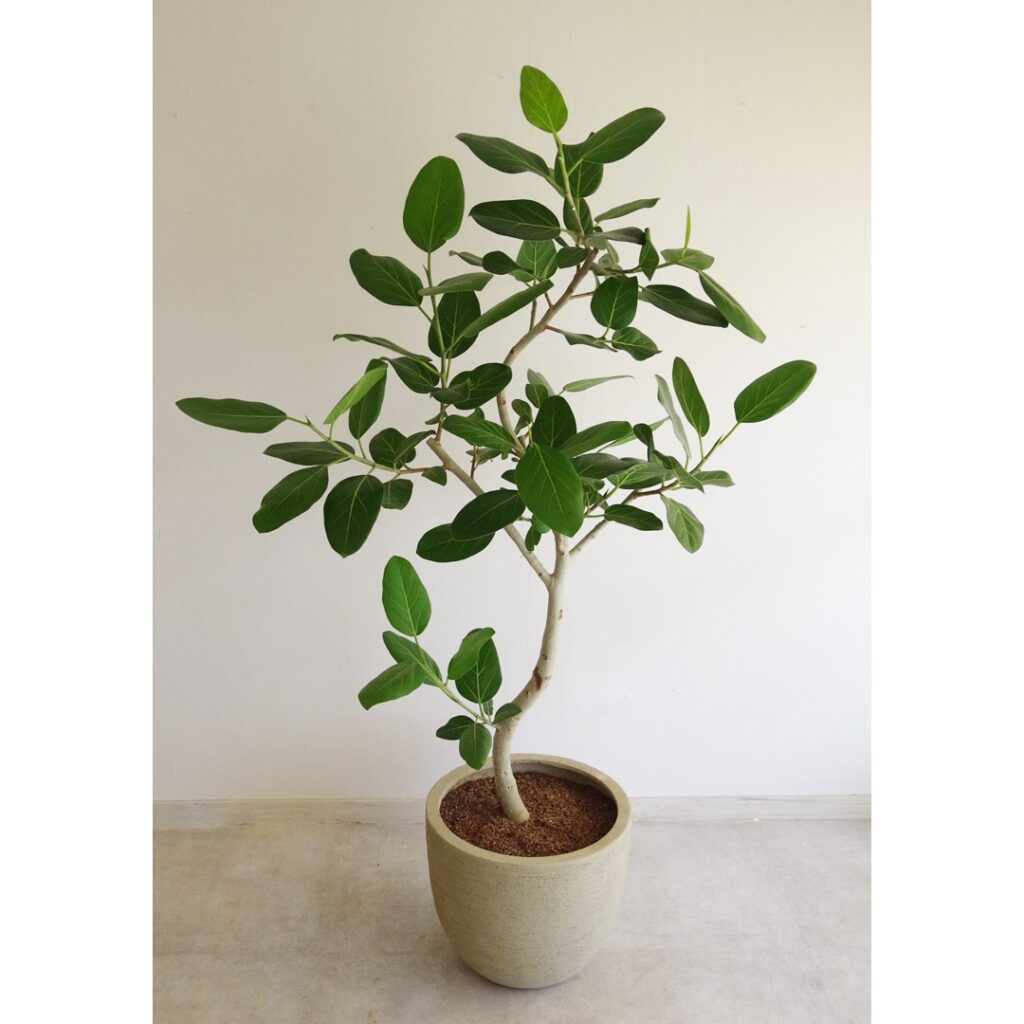
The Banyan Fig Tree (Ficus benghalensis) is a massive, spreading tree known for its distinctive aerial roots that grow downward from its branches, eventually reaching the ground to form additional trunks. Native to India and Pakistan, this remarkable ficus species can grow to enormous proportions in its natural habitat, often covering several acres with its expanding canopy. While it can be grown as a houseplant when young, it’s primarily suited for outdoor cultivation in tropical and subtropical climates where it serves as an important ecological resource, providing food and shelter for various wildlife species.
- Light: Bright, indirect light when grown indoors; full sun to partial shade outdoors
- Water: Regular watering to maintain consistently moist but not waterlogged soil; reduce watering in winter
- Soil: Well-draining, rich organic soil with pH between 6.0-7.0
- Temperature: 60-85°F (16-29°C); cannot tolerate frost
- Humidity: High humidity levels, preferably above 50%
- Fertilizer: Monthly feeding during growing season with balanced fertilizer
- Space: Requires extensive growing space outdoors; can be maintained smaller in containers
- Growth Zone: USDA zones 10-12
5. Indian Laurel Fig Tree
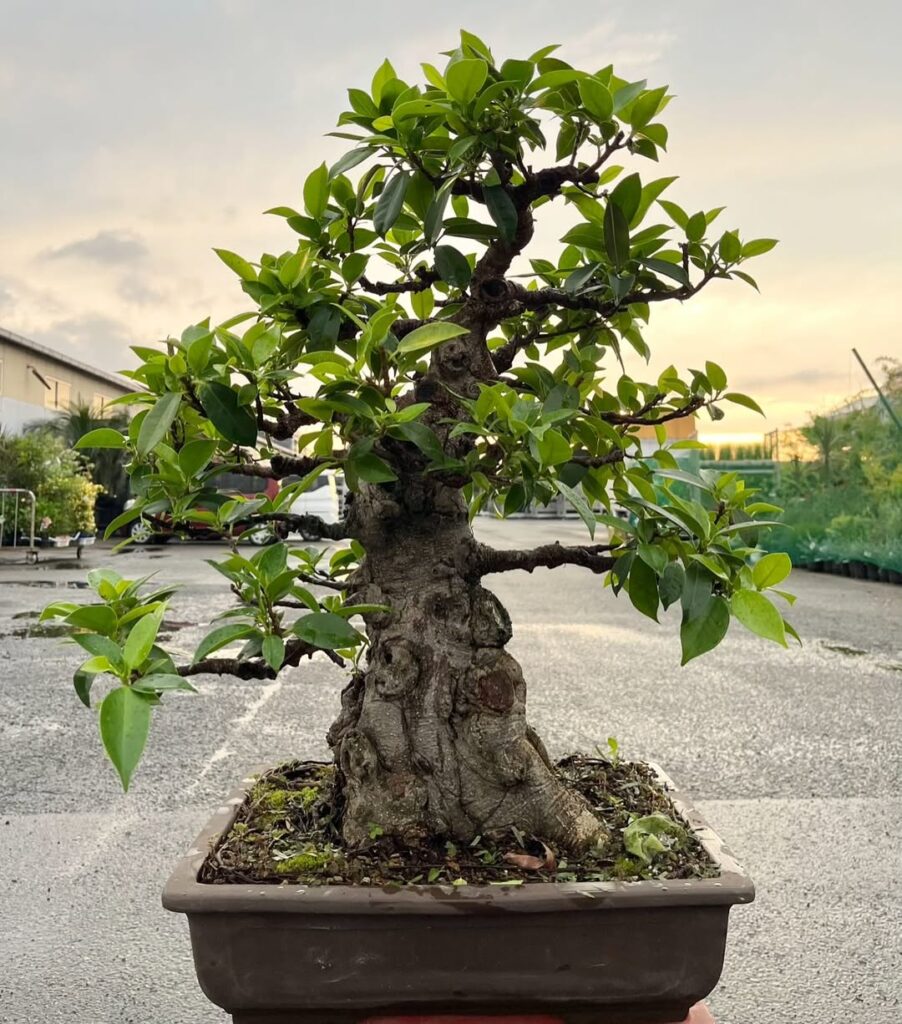
A popular bonsai ficus, the Indian Laurel Fig (Ficus microcarpa) features dense foliage and a strong, twisting trunk. Indoors, it can grow between 4-8 feet, making it a versatile ornamental tree.
- Light: Bright, indirect light indoors; can tolerate full sun to partial shade outdoors
- Water: Moderate watering; allow top inch of soil to dry between waterings
- Soil: Well-draining, rich potting mix with pH 6.0-6.5
- Temperature: 60-75°F (15-24°C)
- Humidity: Moderate to high; benefits from regular misting
- Fertilizer: Monthly feeding during growing season with balanced fertilizer
- Size Control: Responds well to pruning and can be maintained as a compact plant
- Drainage: Requires pot with adequate drainage holes to prevent root rot
Large & Statement-Making Ficus Trees
6. Council Tree
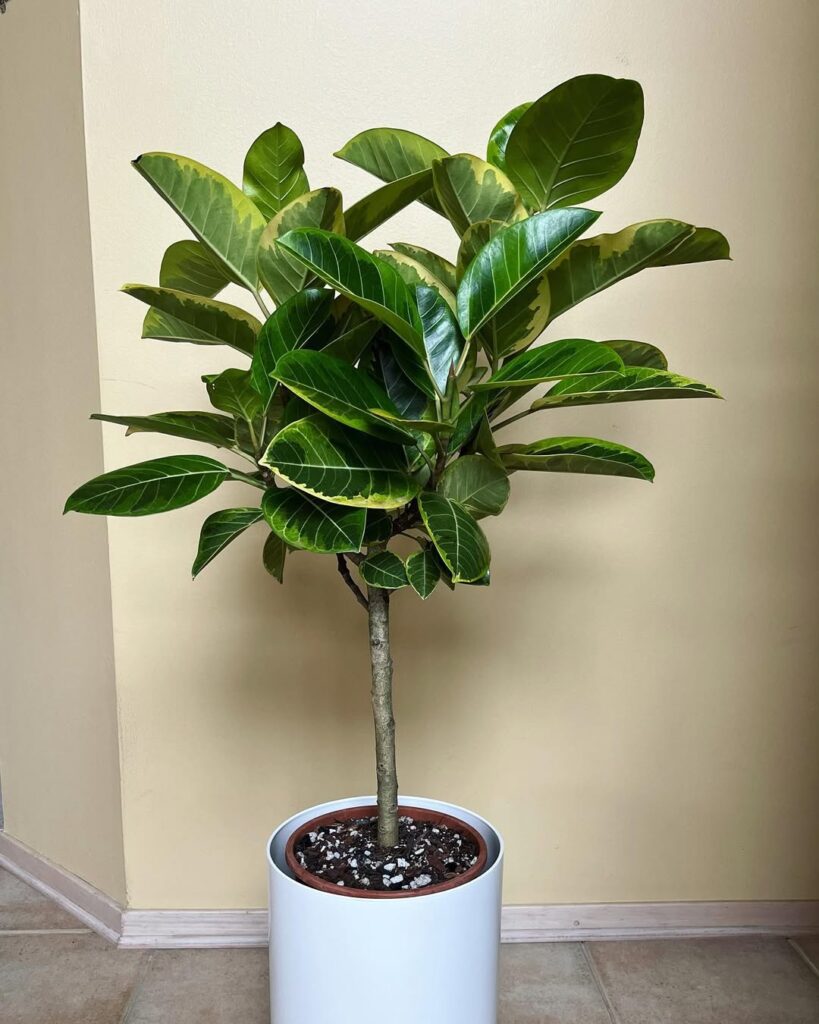
Ficus altissima, also known as the Council Tree, is a striking ficus with broad green leaves and beautiful yellow-green variegation. Indoors, it can grow up to 8-12 feet with proper care.
- Light: Bright, indirect light; thrives in well-lit indoor spaces.
- Water: Water when the top 1-2 inches of soil dry out; avoid overwatering.
- Soil: Well-draining mix with added perlite or sand.
- Humidity: Prefers moderate humidity; misting can help in dry conditions.
- Temperature: 65-80°F (18-27°C); keep away from temperature extremes.
- Fertilizer: Feed monthly with balanced fertilizer in spring and summer.
- Soil pH: Neutral to slightly acidic (6.0-7.0)
7. Sacred Fig
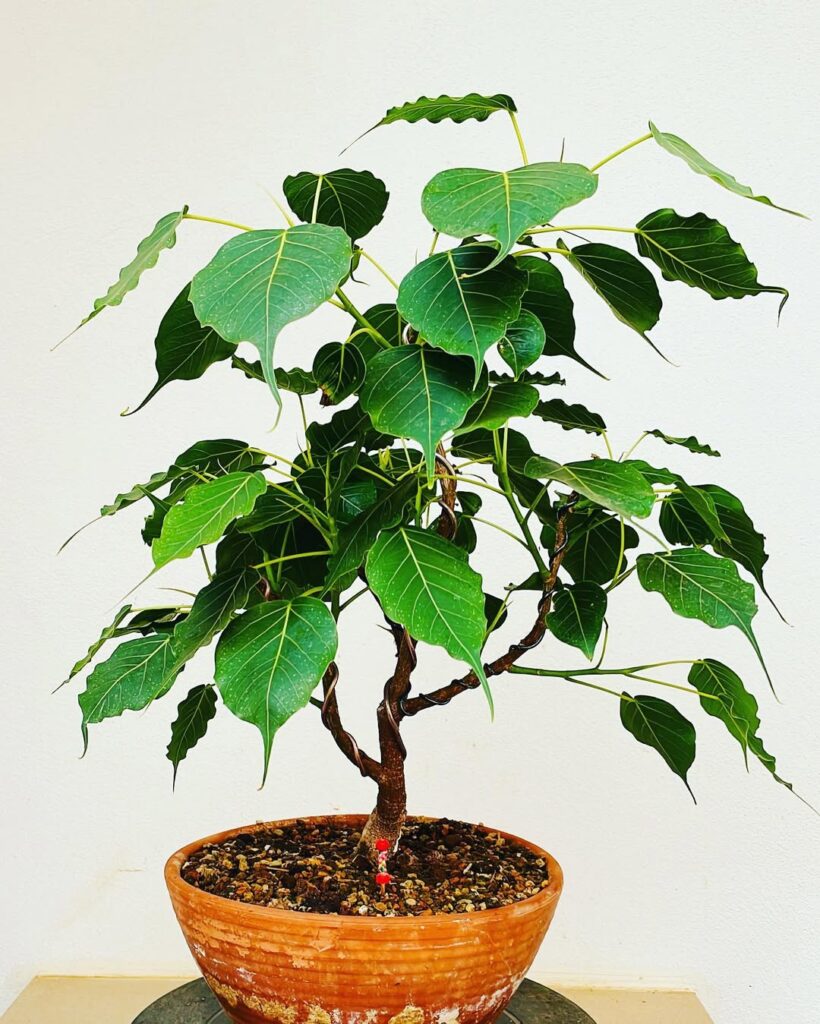
The Sacred Fig (Ficus religiosa), also known as the Bodhi Tree or Peepal Tree, holds deep cultural and religious significance, particularly in Buddhism and Hinduism. This majestic ficus variety can grow to impressive heights in its natural habitat but adapts well as a container plant when grown indoors. It features distinctive heart-shaped leaves with elongated, dripping tips and smooth, gray bark that develops an attractive pattern with age.
- Light: Bright, indirect light with some direct sunlight exposure.
- Water: Water when the top layer of soil is dry; avoid waterlogging.
- Soil: Well-draining, nutrient-rich mix with organic compost.
- Humidity: Prefers moderate to high humidity; misting helps prevent dryness.
- Temperature: 65-85°F (18-29°C); tolerates warm climates well.
- Fertilizer: Feed biweekly during growing season with balanced fertilizer.
- Soil pH: Slightly acidic to neutral (6.0-6.5)
8. Moreton Bay Fig
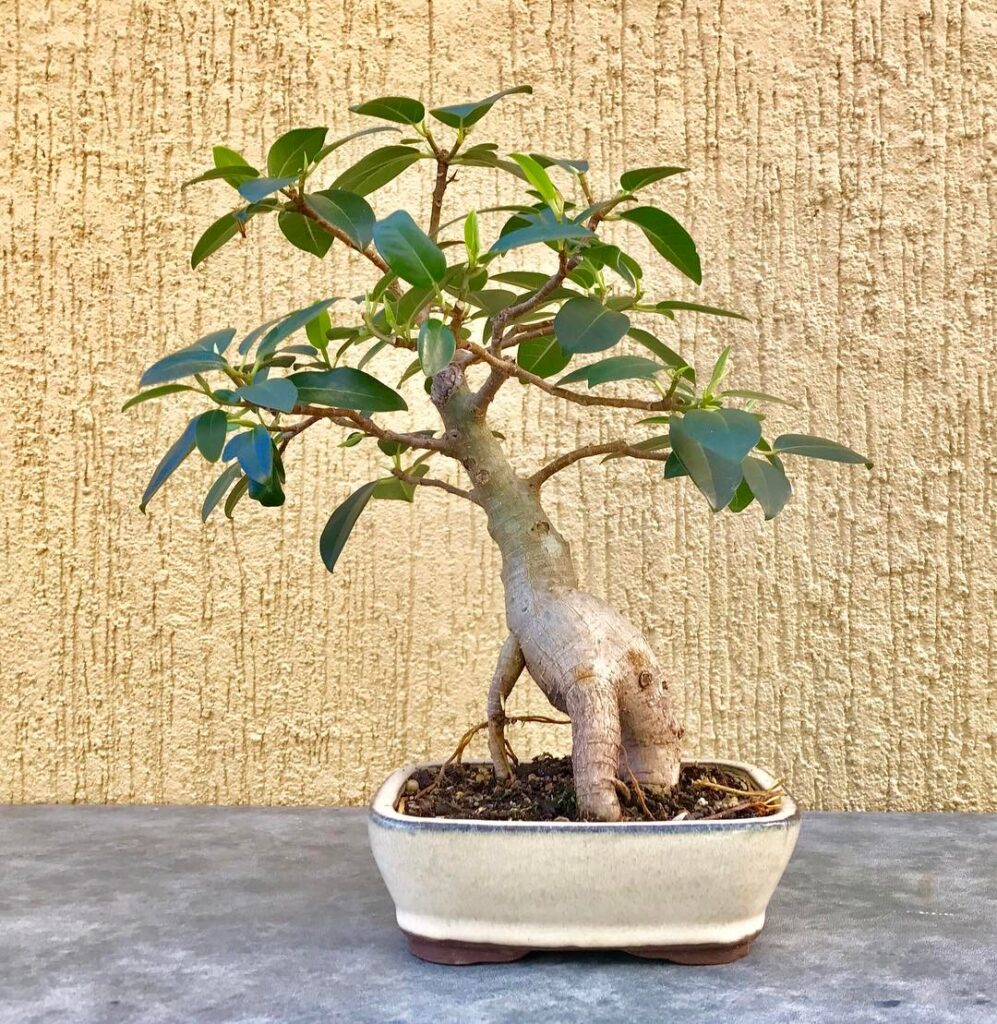
A large ficus species with broad, glossy leaves, the Moreton Bay Fig (Ficus macrophylla) is better suited for spacious indoor environments or atriums. Indoors, it can reach 10 feet, but in nature, it grows much larger.
- Light: Bright, indirect light; tolerates some direct sun.
- Water: Water deeply when the soil dries slightly, ensuring good drainage.
- Soil: Rich, well-draining mix with organic matter.
- Humidity: Prefers high humidity; mist regularly if in dry conditions.
- Temperature: 65-80°F (18-27°C); avoid cold drafts.
- Fertilizer: Monthly feeding with slow-release fertilizer in growing season.
- Soil pH: Slightly acidic to neutral (6.0-6.5)
9. Rusty Fig (Ficus rubiginosa)
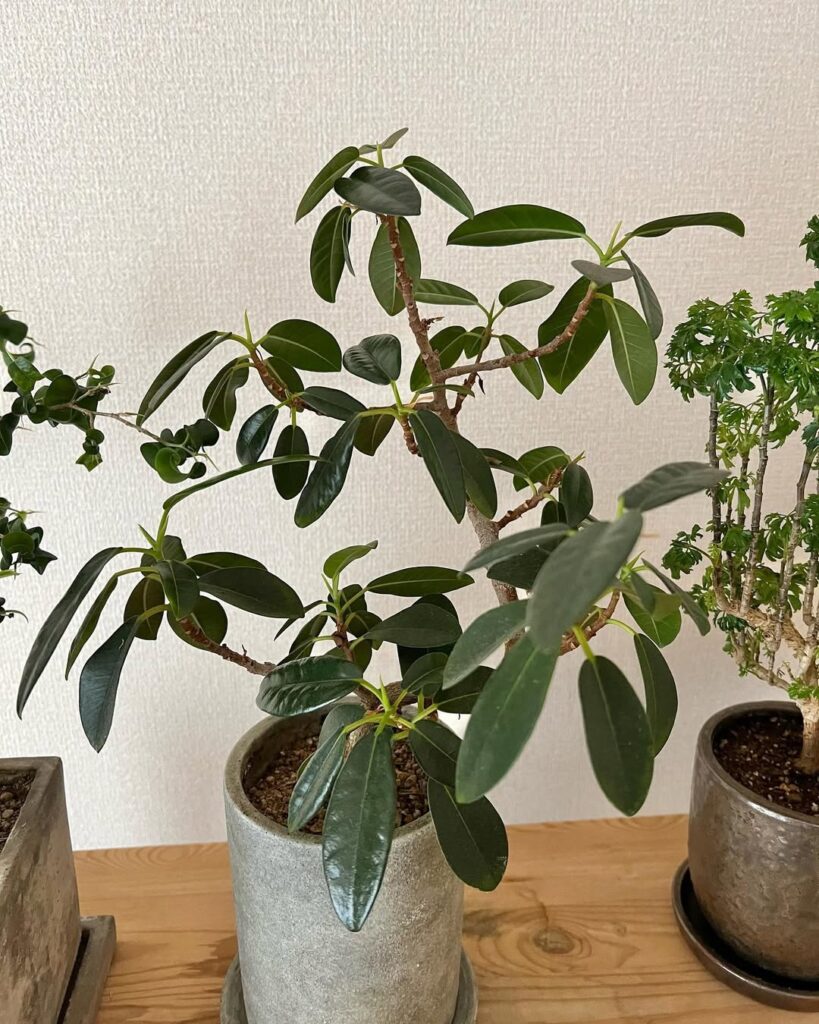
The Rusty Fig gets its name from the reddish hues beneath its leaves. It’s a hardy ficus that adapts well indoors and can reach 6-10 feet in a container.
- Light: Bright, indirect light; tolerates moderate sunlight.
- Water: Water when the top 2 inches of soil feel dry.
- Soil: Well-draining mix with added sand for aeration.
- Humidity: Prefers moderate humidity; occasional misting is beneficial.
- Temperature: 65-80°F (18-27°C); avoid extreme cold.
- Fertilizer: Feed biweekly in growing season with balanced fertilizer.
- Soil pH: Neutral to slightly acidic (6.0-7.0)
10. Ficus Umbellata
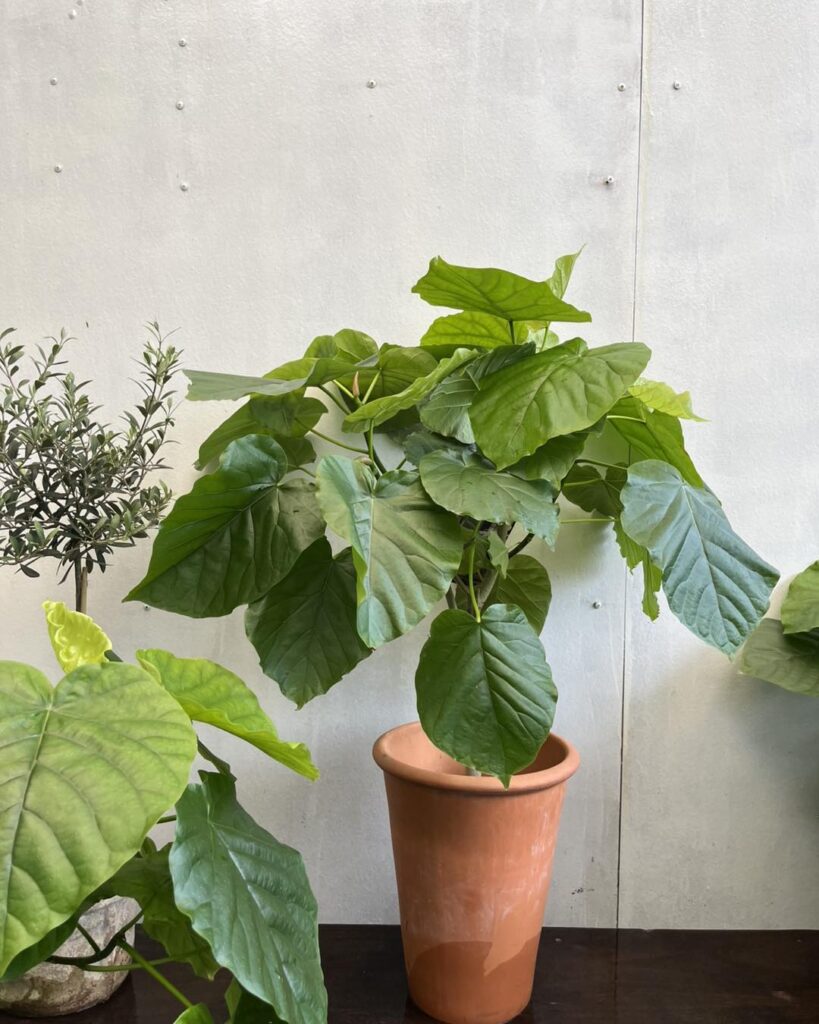
A lesser-known indoor ficus, Ficus umbellata features large, soft leaves that create an airy, elegant aesthetic. Indoors, it typically grows 5-8 feet.
- Light: Bright, indirect light; avoid direct sun exposure.
- Water: Keep soil evenly moist but avoid standing water.
- Soil: Well-draining mix with added peat moss.
- Humidity: Prefers high humidity; misting helps maintain leaf health.
- Temperature: 65-75°F (18-24°C); avoid cold drafts.
- Fertilizer: Monthly feeding with diluted liquid fertilizer.
- Soil pH: Slightly acidic to neutral (6.0-6.5)
Bonsai & Unique Ficus Tree Varieties
11. Ginseng Fig
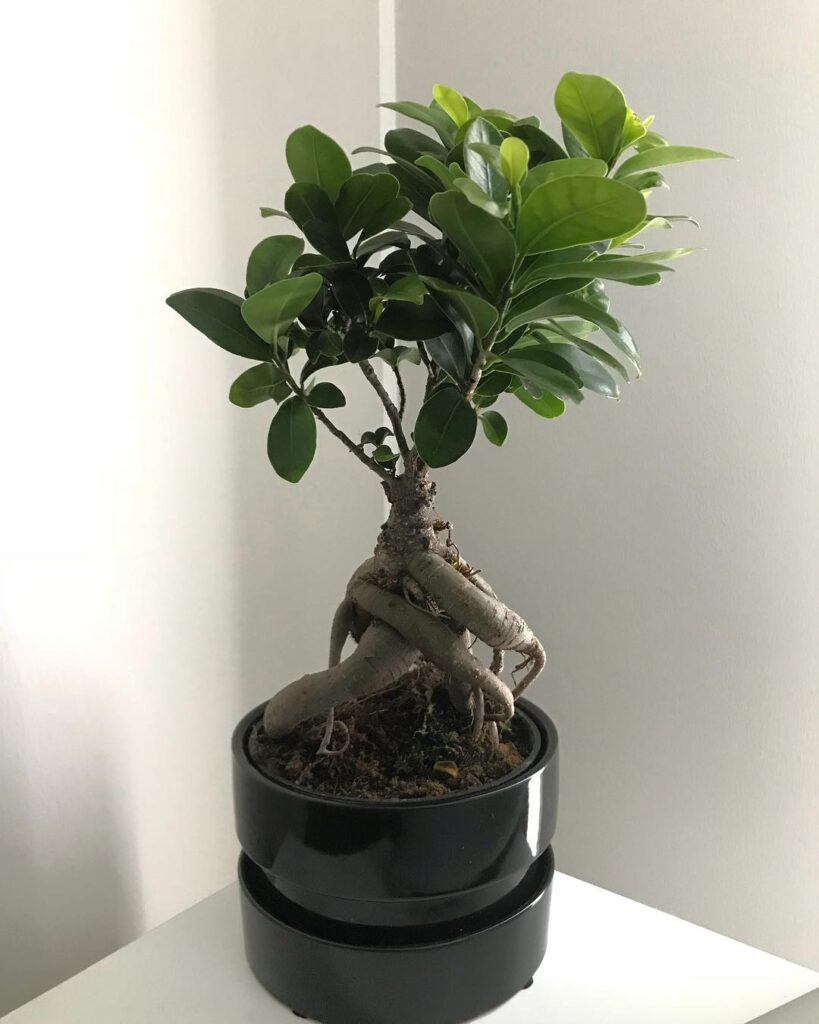
A favorite for bonsai lovers, the Ginseng Fig (Ficus microcarpa ‘Ginseng’) has thick, knotted roots and dense foliage. Indoors, it remains 2-4 feet, making it perfect for compact spaces.
- Light: Bright, indirect light; tolerates some morning sunlight.
- Water: Water when soil feels dry to the touch; avoid soggy conditions.
- Soil: Bonsai mix or well-draining potting soil.
- Humidity: Prefers moderate humidity; misting can prevent leaf drying.
- Temperature: 65-80°F (18-27°C); thrives in stable indoor climates.
- Fertilizer: Feed monthly with bonsai-friendly liquid fertilizer.
- Soil pH: Neutral to slightly acidic (6.0-6.5)
12. Willow Leaf Ficus
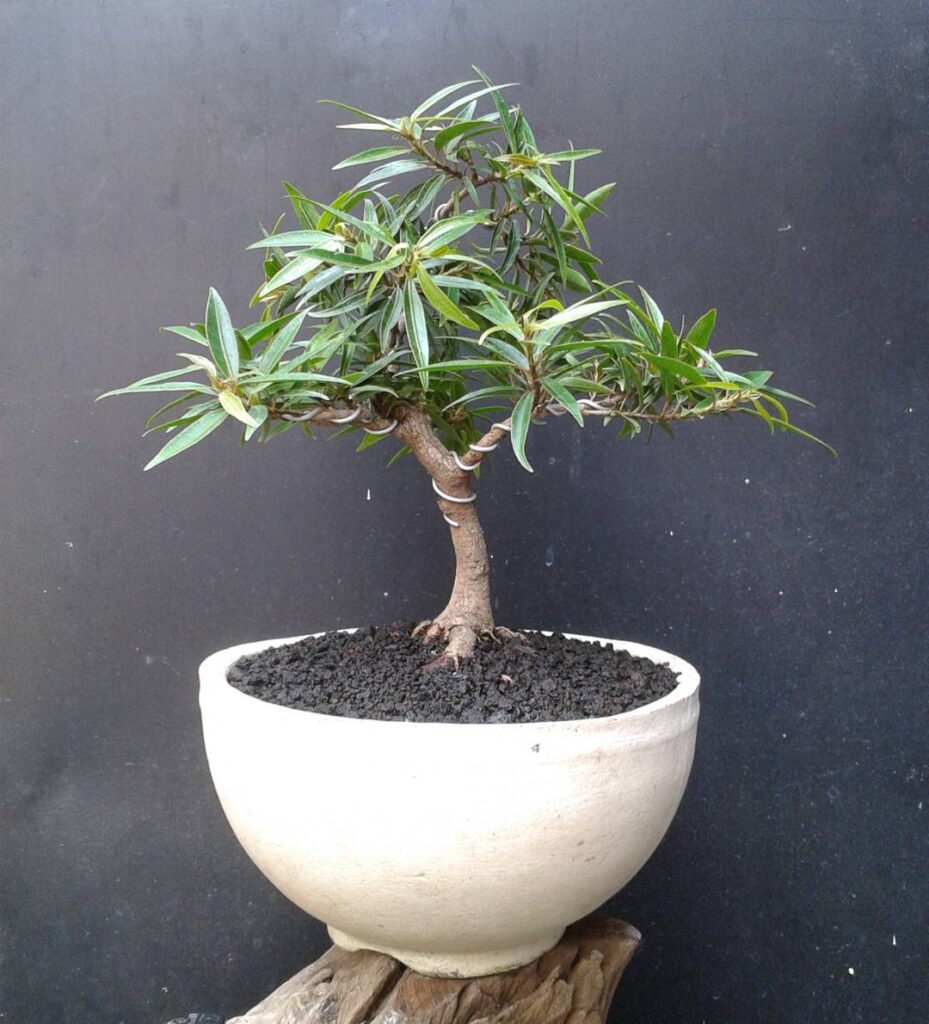
With long, slender leaves resembling willow trees, the Willow Leaf Ficus (Ficus salicaria) is perfect for bonsai shaping. It stays 2-5 feet indoors, with pruning helping control its growth.
- Light: Bright, indirect light; tolerates well-lit indoor spaces.
- Water: Water when top inch of soil dries out; avoid waterlogging.
- Soil: Well-draining bonsai soil or rich potting mix.
- Humidity: Prefers moderate humidity; misting can help leaf retention.
- Temperature: 65-80°F (18-27°C); avoid cold drafts.
- Fertilizer: Feed every 4-6 weeks with balanced liquid fertilizer.
- Soil pH: Neutral to slightly acidic (6.0-6.5)
13. Triangular Ficus
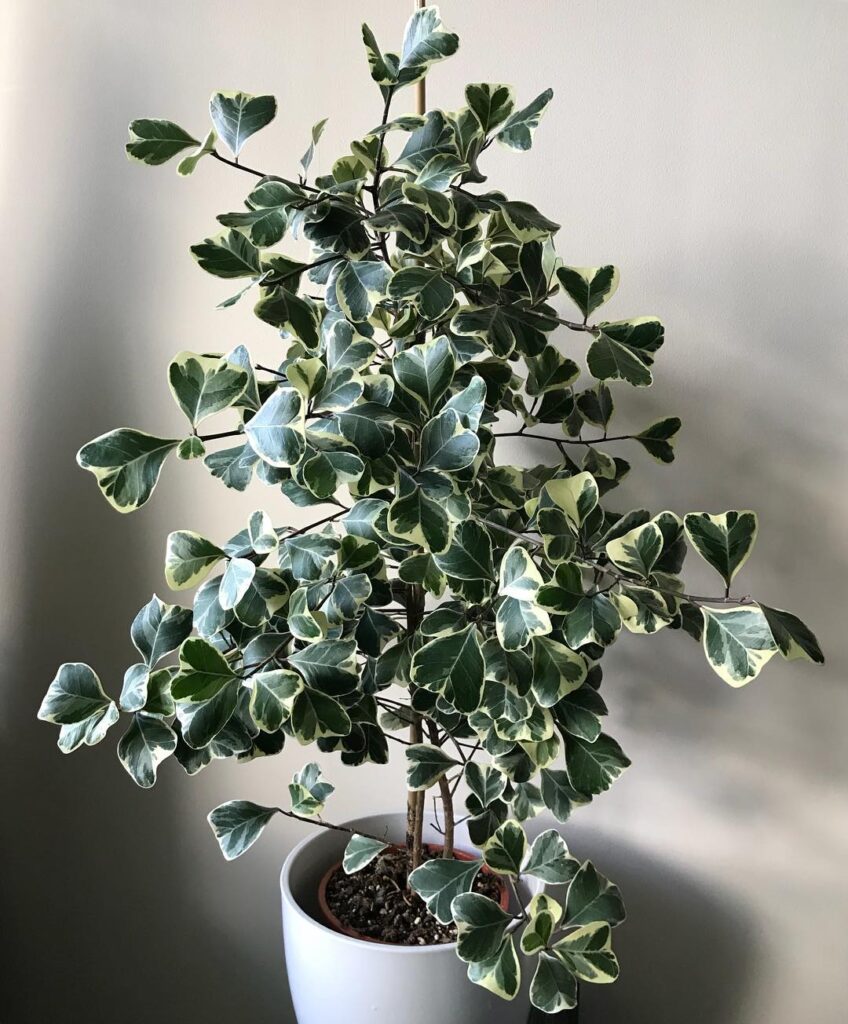
Known for its unique triangular leaves, Triangular Ficus (Ficus triangularis) is a compact indoor ficus that grows 4-6 feet with proper care.
- Light: Bright, indirect light; tolerates some direct sun.
- Water: Water when the top 2 inches of soil dry out.
- Soil: Well-draining potting mix with added perlite.
- Humidity: Prefers moderate humidity; misting can prevent dryness.
- Temperature: 65-80°F (18-27°C); stable indoor temperatures are best.
- Fertilizer: Feed biweekly during growing season with balanced fertilizer.
- Soil pH: Neutral to slightly acidic (6.0-6.5)
14. Cluster Fig
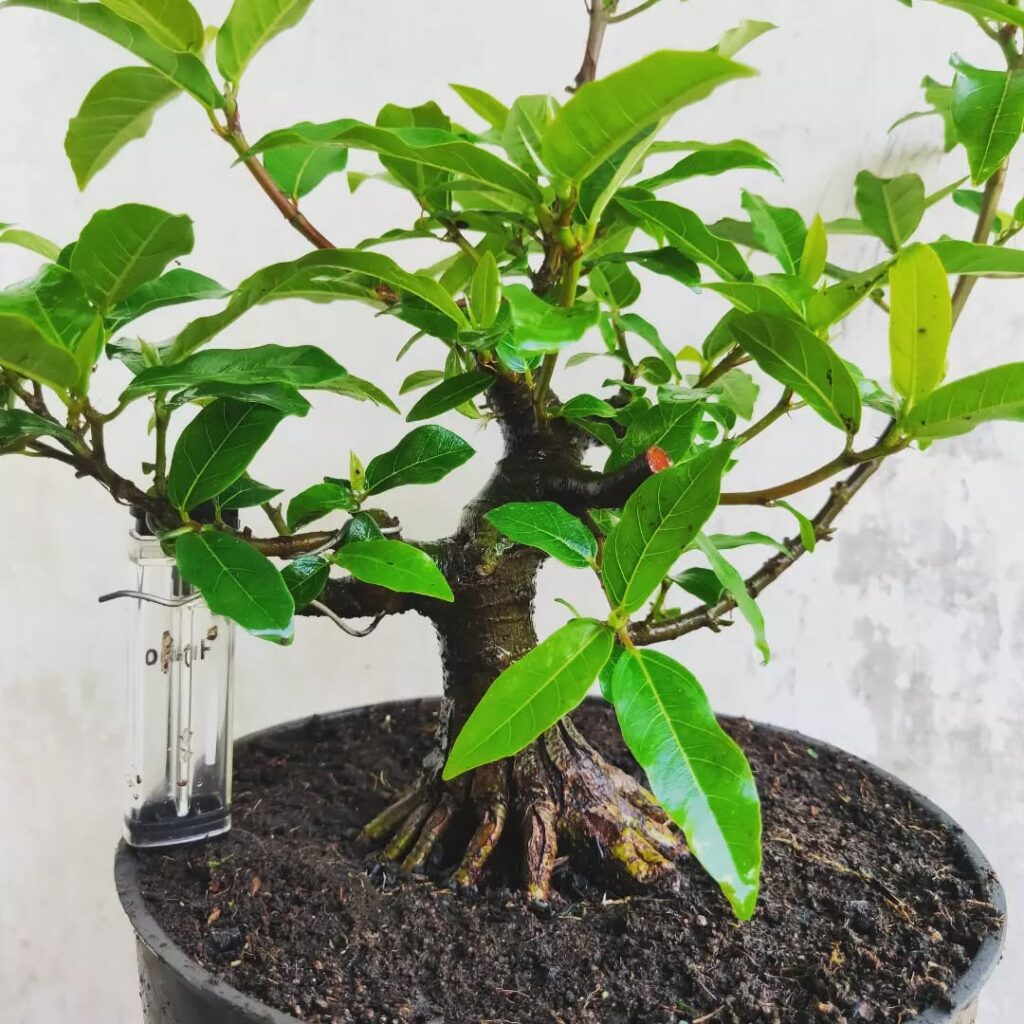
A fruit-bearing ficus, the Cluster Fig (Ficus racemosa) is unusual among indoor ficus trees but can be grown in large containers to control its size. Indoors, it reaches 6-10 feet.
- Light: Bright, indirect light; tolerates some direct sunlight.
- Water: Keep soil consistently moist but well-drained.
- Soil: Nutrient-rich potting mix with compost.
- Humidity: Prefers high humidity; misting recommended.
- Temperature: 65-85°F (18-29°C); avoid cold drafts.
- Fertilizer: Monthly feeding with balanced liquid fertilizer.
- Soil pH: Slightly acidic to neutral (6.0-6.5)
15. Rock Fig
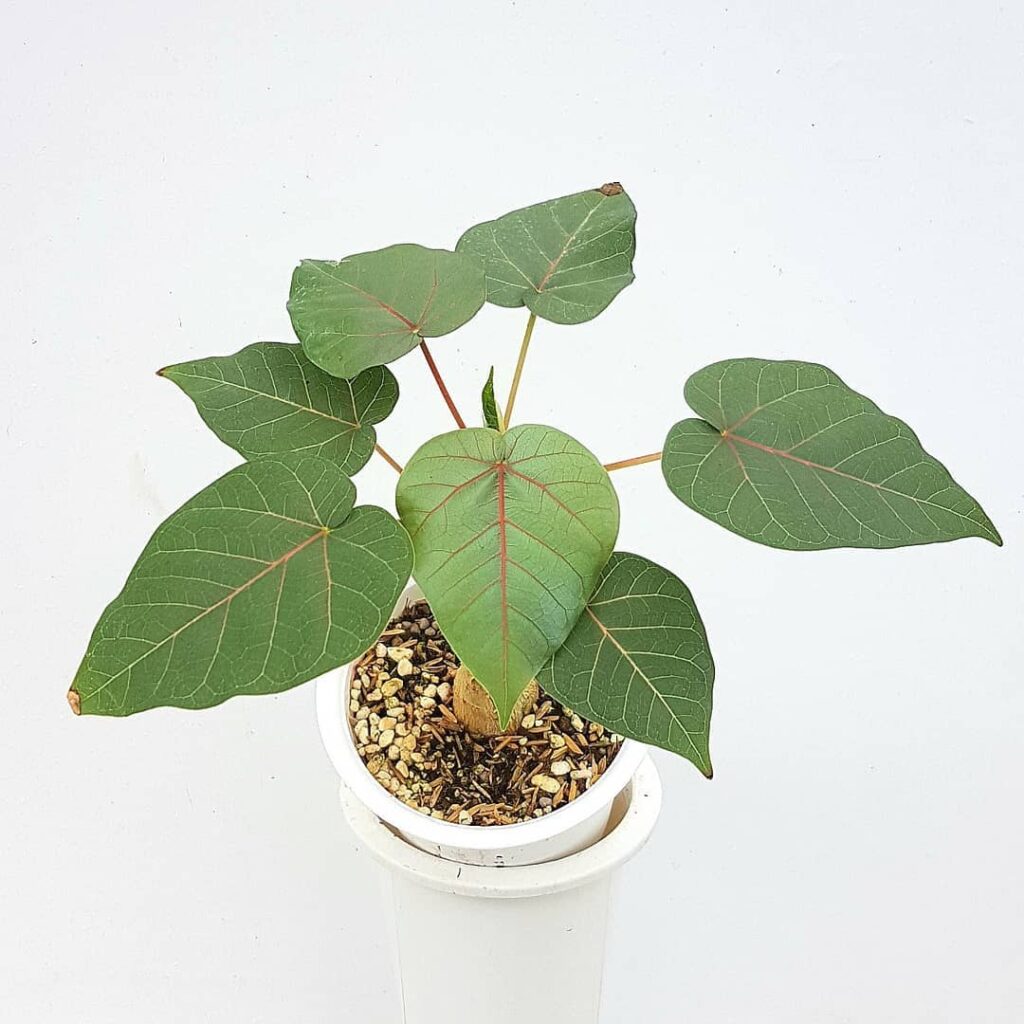
Ficus petiolaris, or the Rock Fig, thrives in arid conditions and features fascinating root structures. Indoors, it typically reaches 4-8 feet.
- Light: Bright, indirect light; tolerates some direct sun.
- Water: Allow soil to dry slightly between watering.
- Soil: Well-draining mix with sand or cactus soil blend.
- Humidity: Prefers moderate humidity; mist occasionally.
- Temperature: 65-85°F (18-29°C); tolerates warmer climates well.
- Fertilizer: Monthly feeding with diluted liquid fertilizer.
- Soil pH: Neutral to slightly acidic (6.0-7.0)
